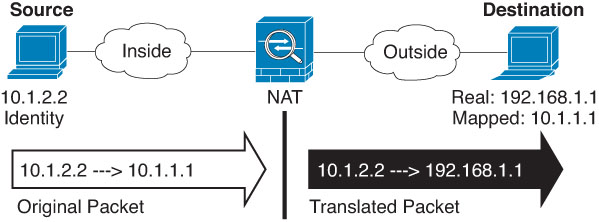Configure Identity Manual NAT
Use static identity manual NAT rules when auto NAT does not meet your needs. For example, if you want to do different translations based on the destination. Use static identity NAT rules to prevent the translation of an address. That is, to translate the address to itself.
Before you begin
Select and create the network objects or groups needed in the rule. Groups cannot contain both IPv4 and IPv6 addresses; they must contain one type only. Alternatively, you can create the objects while defining the NAT rule. The objects must also meet the following requirements:
-
Original Source—This can be a network object or group, and it can contain a host, range, or subnet. If you want to translate all original source traffic, you can skip this step and specify Any in the rule.
-
Translated Source—The same object or group as the original source. Optionally, you can select a different object that has the exact same contents.
You can also create network objects or groups for the Original Destination and Translated Destination if you are configuring a static translation for those addresses in the rule. If you want to configure destination static interface NAT with port translation only, you can skip adding an object for the destination mapped addresses and specify the interface in the rule.
You can also perform port translation on the source, destination, or both. In the Object Manager, ensure that there are port objects you can use for the original and translated ports. You can use the same object for identity NAT.
Procedure
Step 1 | Select and create or edit the Firewall Threat Defense NAT policy. |
Step 2 | Do one of the following:
The right click menu also has options to cut, copy, paste, insert, and delete rules. |
Step 3 | Configure the basic rule options:
|
Step 4 | On Interface Objects, configure the following options:
|
Step 5 | Identify the original packet addresses, either IPv4 or IPv6; namely, the packet addresses as they appear in the original packet. See the following figure for an example of the original packet vs. the translated packet where you perform identity NAT on the inside host but translate the outside host. 
|
Step 6 | Identify the translated packet addresses, either IPv4 or IPv6; namely, the packet addresses as they appear on the destination interface network. You can translate between IPv4 and IPv6 if desired.
|
Step 7 | (Optional.) Identify the source or destination service ports for service translation. If you are configuring static NAT with port translation, you can translate ports for the source, destination, or both. For example, you can translate between TCP/80 and TCP/8080. NAT only supports TCP or UDP. When translating a port, be sure the protocols in the real and mapped service objects are identical (both TCP or both UDP). For identity NAT, you can use the same service object for both the real and mapped ports.
|
Step 8 | (Optional.) On Advanced, select the desired options:
|
Step 9 | Click Save to add the rule. |
Step 10 | Click Save on the NAT page to save your changes. |
